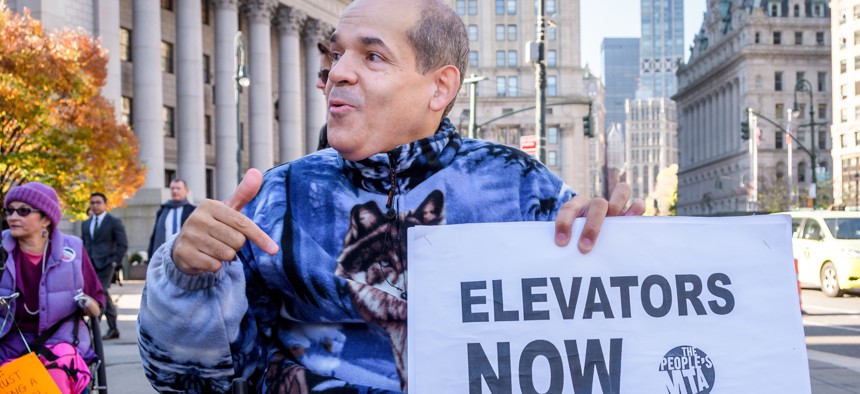New Grants Now Available to Make Local Rail Stations ADA Compliant

A participant on a wheelchair protesting outside a courthouse in New York City in 2019, while a judge held a hearing inside in a lawsuit brought to require elevators in all of the city's subway stations. Erik McGregor/LightRocket via Getty Images
The federal funding is aimed at retrofitting a portion of the more than 900 subway, commuter rail and light rail stations built before the Americans with Disabilities Act became law.
The Biden administration opened up applications Tuesday for $343 million in grants for local transit agencies to make their rail stations more accessible to people with disabilities.
The grants were included in part of last year’s federal infrastructure funding law. They are aimed at retrofitting a portion of the more than 900 subway, commuter rail and light rail stations that were built before the Americans with Disabilities Act became law in 1990. The ADA, among other things, requires public facilities to be able to accommodate people with disabilities.
“While our country has made enormous progress in the three decades since passing the Americans with Disabilities Act, too many people with disabilities still don’t have access to reliable public transportation,” Transportation Secretary Pete Buttigieg said in a statement.
“Using funds from President Biden’s Bipartisan Infrastructure Law, we are modernizing some of our oldest public rail stations and ensuring that more Americans count on our transit systems to get where they need to go,” he added.
The $343 million is for the first of five years’ worth of funding for the initiative.
About 17% of transit stations in the country are not ADA compliant, according to federal data.
The grants from the All Stations Accessibility Program are significant, because they mark the first time the federal government has specifically set aside money for making stations more accessible.
Despite the name of the program, though, the grants are not nearly enough to make all stations accessible.
New York City, which has both the biggest transit system in the country and the highest number of inaccessible stations, is a big reason why. It has nearly half of the remaining inaccessible systems in the country. Just 126 of its 472 stations have accommodations for people with disabilities, such as ramps or elevators.
The Metropolitan Transportation Authority, in response to two lawsuits, has agreed to make all of its stations accessible by 2055. But just the cost of bringing the Broadway Junction station up to ADA standards with seven elevators would cost $427 million, according to MTA budget documents. The 168th Street station upgrades are expected to cost between $175 million and $385 million.
“The cost, given the type of station and the location is going to be – I wouldn’t call it exorbitant – but certainly it’s going to put a big dent in [MTA’s] capital budget,” Nuria Fernandez, the head of the Federal Transit Administration, told reporters. (Fernandez had once worked as the chief operating officer for the MTA.)
Fernandez said, though, that the new federal money would still be useful, especially when combined with other federal grants that could be used to make those improvements.
“We know it’s oversubscribed. There’s more need than the funds that are going to be available for five years,” she said. “But transit agencies do have access to [capital maintenance] funds, which will provide them with the ability to start making the necessary changes at their stations.”
The $1.75 billion program is a fraction of the $10 billion over 10 years that U.S. Sen. Tammy Duckworth, an Illinois Democrat who uses a wheelchair, and several other lawmakers originally had called for during negotiations over the infrastructure bill. Negotiators trimmed the size of the package in order to win bipartisan support in the upper chamber.
A Dozen Agencies Qualify
More than a dozen agencies have stations that qualify for the grants. Fernandez said she couldn’t provide an estimate about how many would be upgraded with the available funds until the agencies submitted their applications.
New York’s subway system has about 342 stations that are not ADA compliant, according to a 2020 FTA database of transit stations. The agencies with the next-highest numbers of non-compliant stations are:
- SEPTA in Philadelphia, with 170.
- New Jersey Transit, with 93.
- The Boston area’s MBTA, with 71.
- Metro North in New York and Connecticut (run by MTA), with 65.
- Metra commuter rail in the Chicago area, with 52.
- The Chicago Transit Authority with 42.
- The Long Island Railroad (run by MTA), with 17.
- The Maryland Transit Administration, with 16.
- The Staten Island Rapid Transit Operating Authority (run by MTA), with 16.
Agencies must submit their applications by the end of September.
Daniel C. Vock is a senior reporter for Route Fifty based in Washington, D.C.
NEXT STORY: State election officials struggle with paper shortages, harassment, insider threats






